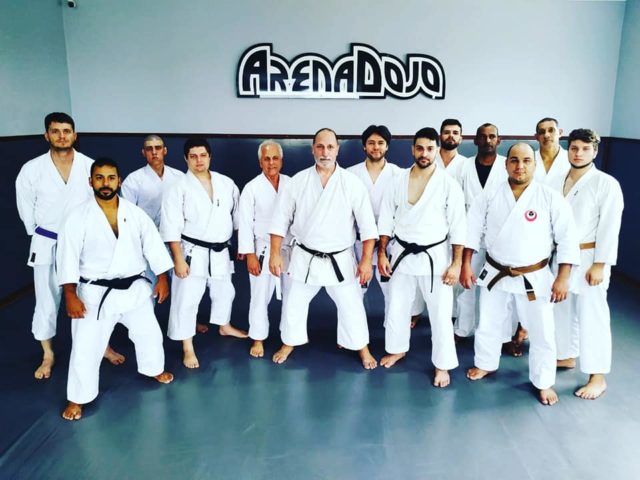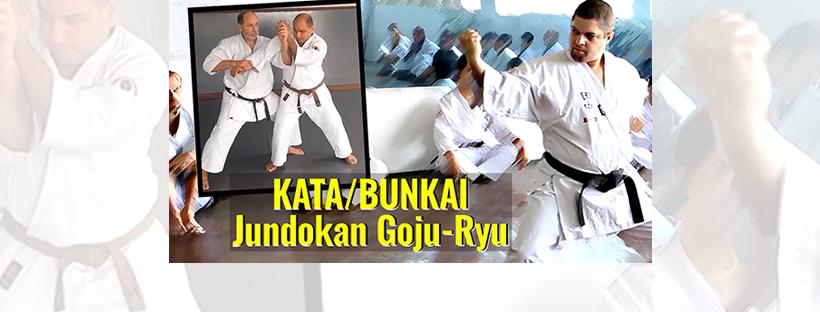In November of 2019 I attended the Gasshuku of the Jundokan school. The Jundokan is a school founded in Okinawa by master Eiichi Miyazato, who was a direct student of Chojun Miyagi. It is considered one of the schools that best preserves how master Miyagi taught Karate after World War II, before he died. So it is a very important link for us to better understand Karate, how it was practiced in the past and the changes that were made later.
This video has English subtitles
Jundokan is also considered a very private school and has few representatives around the world. So much so that the only official representative here in America Latina is the sensei Pablo Scurzi from Argentina, who presented the seminar. Under the tutelage of Scurzi there are schools in Chile, Colombia and Brazil.
The seminar took place on the 16th and 17th in the city of Linhares, in Espírito Santo. And this event was organized by sensei Thulio Gandra, a friend of mine who does a very nice job at Espírito Santo and is a student of Scurzi.
At the seminar we had the opportunity to study the versions of some kata of Jundokan and also explore a little bit of the bunkai possibilities of that school. Among the kata practiced were Gekisai Dai Ichi, Saifa and Seyunchin.
But I was not alone in this event. I was accompanied by my good friend Samir Berardo, from Muidokan Karate Kenkyukai, of which I am also a member, in addition to being a member of the Karate-Do Tanaka Association. Also in the schedule of the event in addition to the classes taught by sensei Scurzi there were also private trainings that we realized of the content of Muidokan with the students of sensei Thulio.
So it was an opportunity to complement: in addition to studying the bunkai of Jundokan we also studied a little bit of bunkai and techniques from Muidokan, and managed to notice some similarity between the two.
Adding everything up we trained around 18 hours that weekend. We arrived on Friday night, trained at dawn, the next morning we had training with sensei Scurzi, then there was a break, we went back to training with sensei Scurzi and had training at night with Samir teaching the content of Muidokan. On Sunday morning there was again a seminar with sensei Scurzi concluding his content, then there were more training of the Muidokan content for sensei Thulio’s group. So it was a very intense and very cool exchange and sharing of Karate. And even more: quality Karate.
Jundokan’s bunkai has a very interesting feature that they call Renzoku Bunkai, which is the continuous connection of the movements from beginning to end of kata. For each one movement, the opponent may have an answer and from that there is a connection that leads to the next movement. This type of approach is not exclusive to Jundokan, but this is one of the organizations that does best this type of bunkai. Another exponent in the work with Renzoku Bunkai is the sensei Masaji Taira, who was a student of Miyazato and former instructor of Jundokan.
This type of bunkai demonstrated by sensei Scurzi has several elements in common with the research carried out by Muidokan, by Samir Berardo. Although they have some different approaches and strategies, the idea of connecting the kata, of one movement leading to another, is very present in the bunkai performed by Muidokan, which I, in particular, consider to be of a high level and it was one of the things that led me to join that organization.
This Muidokan bunkai, which has specific characteristics and approaches, but that in a way complement what was presented by sensei Scurzi at Gasshuku, could be checked by those who participated of the seminar I organized with Samir Berardo in May 2019.
This bunkai, based on continuous connections and movements, has a short distance context, which is proper for the original approach of Karate, which was self-defense. As time passed, Karate was modernized, it was transformed into a sport and competitions started to emphasize for punches and kicks that came from medium and long distance. But in self-defense you don’t have that luxury and you work not only with punches and kicks but with grips, with locks, with chokes, throwing and attacks to the vital points. And this is exactly what we saw in this bunkai presented by both Jundokan and in the complement later made by Samir, with the content of Muidokan.
So you see: this weekend was for training different things, different schools, one originated in Okinawa and a research group here in Brazil, but that for their quest to understand, with a critical sense, kata and Karate, reached conclusions that complement each other. And we can only gain from that, right?
What I get most from this Gasshuku training weekend, besides obviously of having studied a little more of the Karate from Jundokan, which was already a will of mine, was to see the similarities of this Karate that I myself had been studying and practicing both in Muidokan and in my private research, it was the integration the opportunity to train with both sensei Scurzi and my friends sensei Samir and sensei Thulio.
And besides that, I made a lot of friends too. We trained, did the kata and did the duo exercises smiling, having fun, because we were sharing Karate. Whenever I can, I participate in training outside, in seminars, and I always learn something new, even if it is only one thing to incorporate in my Karate and to add to my study of this martial art. We win when we keep our spirit open for exchange, to complement the our knowledge and even to reassess some things that we thought knew, but what new facts can bring a different perspective. And so the people always grow.
So, I can only thank sensei Thulio Gandra for inviting me and Samir to participate in this event, to sensei Scurzi for his availability, willingness and friendliness to teach a little bit of Jundokan Karate for us. And for all companions, all the participants who were at that event and who contributed in a very positive and very cordial way to make the event an excellent one. I thank all of you who participated and I thank you too, for reading my content.

